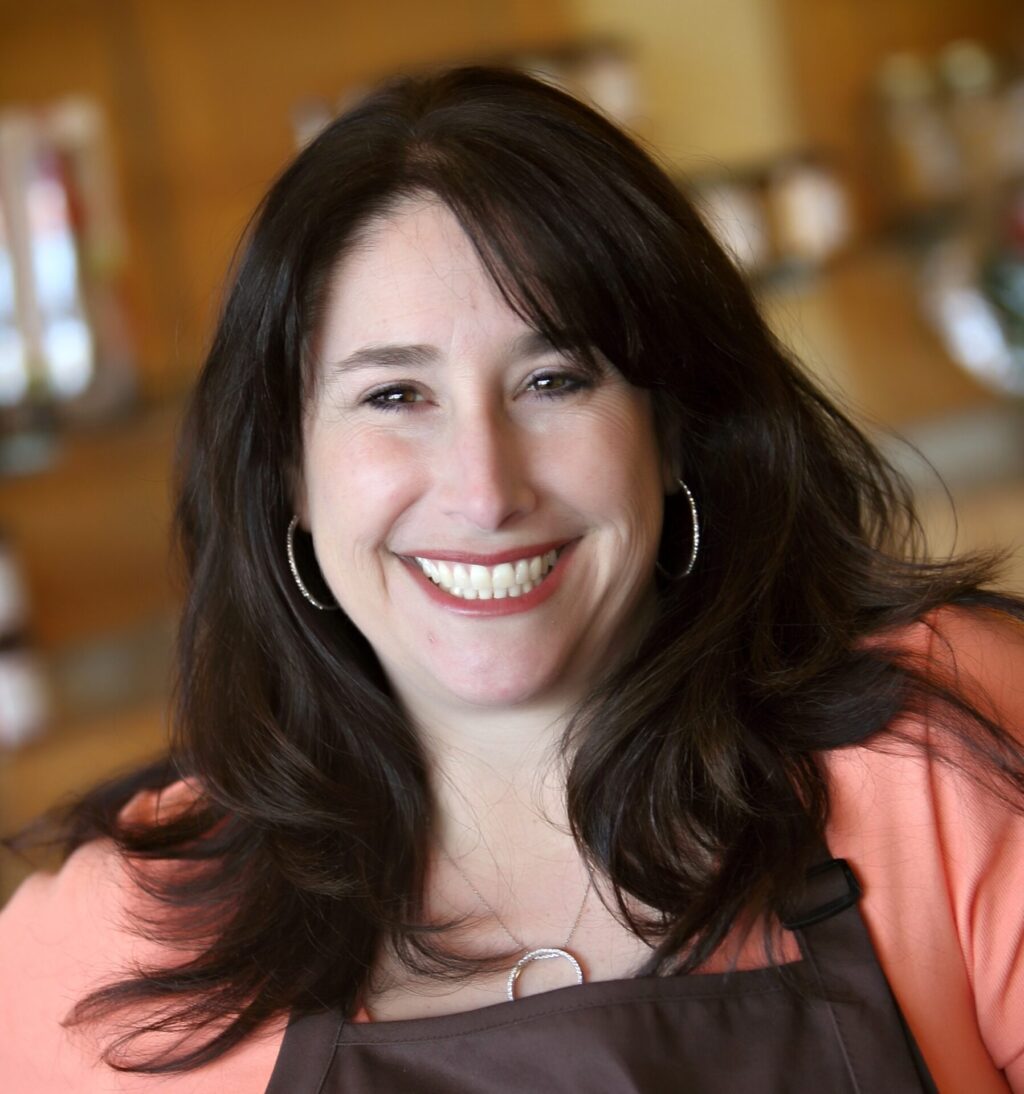Spice Up Passover

March 15, 2021
Top Ten Tips for Spicing up Your Passover Seder
If there is one person who knows how to bring more pizzazz to the seder table this Passover, it’s Debbie Kornberg. The owner of Spice + Leaf, a company specializing in curated spice blends that brings Mediterranean flavor and flare to home cooking, Debbie has been offering “Spice It Up with Deb” cooking classes, both in-person and online, since long before the pandemic and will be leading a live, free, virtual Passover cooking class, open to anyone in the country, featuring some of her favorite holiday recipes on March 17.
As the President of Jewish National Fund-USA’s (JNF-USA) San Diego board, Debbie says that she loves teaching classes that allow her to weave concepts about Judaism and Israel together with her cooking. Debbie’s special Passover class with JNF-USA will be an opportunity for mothers, daughters, bubbes, and aunts to prepare for the holiday “together” no matter where they are located. You can register for this free event at jnf.org/cookingwithdeb.
Debbie and her husband, Rabbi David Kornberg of Congregation Beth Am, are accustomed to hosting seders of all shapes and sizes. Whether you’re having a small intimate crew this year or gathering with family over Zoom, here are her top ten tips for a successful seder.
1.Be prepared!
Passover is not the time to wing it! To take the guesswork out of the preparations, Debbie has a notebook where she keeps her holiday menus, shopping lists, and details about how many guests have attended previous seders, so that she can go back and see how much food to purchase and prepare.
2. Plan a menu that makes sense
If you’re having guests, remember to plan for vegetarians and to take other dietary needs and food sensitivities into account to make sure that everyone has something to eat.
3. Try a “karpas bouquet”
There are many ways to put a new twist on traditional elements of the seder. “My husband’s family is from eastern Europe, so they use potatoes as the karpas and my family is fourth-generation American, so we use parsley,” Debbie says. “We started out using both, and then we branched out to incorporate other foods like cucumbers, jicama, and radishes.” Debbie says that any vegetable that grows from the ground is fair game (as opposed to something like an avocado, which grows from a tree). These bouquets also do double-duty: they make beautiful centerpieces and – once the blessing is said (the ending is “Borei Prei Ha’adamah”), you can continue to eat the different vegetables throughout the seder.
4. Spice up your charoset
Experimenting with different kinds of charoset can be a real treat. Where Ashkenazi charoset usually consists primarily of apples, nuts, wine, and cinnamon, Sephardic and Mizrahi versions may include a variety of dried fruits (dates, figs, apricots, raisins) and spices like ginger, cardamom, allspice, and nutmeg – don’t be afraid to try something new!
5. Give them something to talk about
When it comes to telling the story of Passover, Debbie says her family always plans ahead to ensure a lively discussion that will include both the kids and adults at the table. “One year, my family prepared a trial for the ‘wicked child’ [one of the four children discussed in the text of the Haggadah],” she says, “The kids acted as the defense and prosecution lawyers and had to make the case for why the wicked child was innocent or guilty, with the adults acting as the jury.”
6. Don’t be shy when it comes to singing
One of Debbie’s favorite parts of the seder is the music, which extends far beyond what you will find in a Haggadah. She says you don’t have to be a great singer to participate, and that her family enjoys singing everything from traditional Passover songs, to freedom songs like “If I Had a Hammer,” to a version of “These Are a Few of My Favorite Things,” with Passover lyrics.
7. Choose the right Haggadah
Choosing a Haggadah that’s right for you and your family sets the tone for the whole seder. By shopping around and finding one that resonates with you, you’ll feel more inclined to have a robust, meaningful seder.
8. Have a wine tasting
There’s no reason why you have to drink the same wine all night. Use the four cups of wine throughout the seder to try a variety of wines. You might want to have a selection of Israeli wines, or different color wines, or some with bubbles (and don’t forget the grape juice for children and any guests who don’t drink alcohol). Check out JNF-USA’s online marketplace for some great selections of Israeli wines.
9. Bring the fun
Having activities for the children at the table will help keep them busy and also make a festive “tablescape!” Debbie suggests Passover sticker books, toy plague sets, and Legos or other small building blocks for constructing pyramids.
10. Make the most of Zoom
While we can all agree that there is no replacement for being together in person, Debbie suggests optimizing some of the features on Zoom to make your seder a truly interactive experience, such as taking polls or using breakout rooms to divide into small discussion groups (for example, one for kids and one for adults), before coming back together as a group.
To hear more of Debbie’s Passover tips and to learn how to cook new mouthwatering recipes for your seder, register for her free live, virtual cooking class on March 17 at jnf.org/cookingwithdeb.
Passover Crispy Orange Chicken with Ginger and Honey 
By Debbie Kornberg
(Serves 4 – 6)
This dish is always a hit with my family! I use the recipe year–round but it is particularly a favorite for Passover! The orange, ginger, and honey play well together and the crispy coating around the chicken ensures it stays moist. If you are having a big crowd, you will want to double or triple the recipe as needed.
Ingredients:
4 boneless chicken breasts (cut pieces in half)
1 cup matzah meal (can use almond flour)
1 Tbsp potato starch
2 heaping Tbsp onion powder
1/2 tsp ground turmeric
1/4 tsp ground cumin
Pinch of salt
3 eggs
1 cup grapeseed oil
2 small baby carrots (trust me on this!)
1/8 cup olive oil
1/2 cup orange juice
1/4 cup honey
2 tsp ground ginger
1 orange (half for zesting and the other half cut into slices)
Instructions:
- Preheat oven to 350 degrees.
- In a bowl, combine matzah meal, potato starch, onion powder, turmeric, cumin, and salt. Mix well.
- In a separate bowl, crack eggs and whisk well.
- Heat the grapeseed oil in a large frying pan on medium-high heat. Place baby carrots in oil. You will know the oil is hot when the carrots start to sizzle, plus the carrots will help prevent the chicken from burning. (Use this trick when frying anything, like latkes.)
- Dip chicken breast in egg and then dip into flour blend so it is well coated.
- When oil is hot, place coated chicken into hot frying pan and cook until it is a deep golden brown on both sides.
- Once chicken is cooked, place directly into a baking dish.
- In a different bowl, combine olive oil, orange juice, honey and ground ginger. Whisk everything together very well.
- Using a zester, zest the skin of half of an orange into the sauce and mix well.
- Carefully pour orange-ginger sauce around the chicken. Best not to pour on top of chicken as it will make the chicken less crispy.
- Cut remaining 1/2 of orange into to half slices and place around the chicken.
- Place in oven and cook for approximately 30 minutes.
- Serve warm!
*This article is featured in the print Jewish Journal Passover edition
